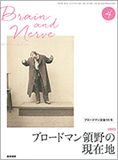Japanese
English
- 有料閲覧
- Abstract 文献概要
- 1ページ目 Look Inside
- 参考文献 Reference
ブロードマンは辺縁葉の範囲のうち,海馬の周辺に27,28,34,35,36野を,脳梁の周辺に23,24,25,26,29,30,31,32,33野を区別した。24,25,32,33野は帯状回前部,23,26,29,30,31野は帯状回後部を占める。25,32野と24野前下部は情動反応に深く関わる。29,30野は23,31野,前頭前野背外側部,27,28,35,36野と密に連絡し,空間認知,ワーキングメモリ処理,エピソード記憶形成の間を仲立ちする。
Abstract
The limbic lobe defined by Broca is a cortical region with highly diverse structure and functions, and comprises the paleo-, archi-, and neocortices as well as their transitional zones. In the limbic lobe, Brodmann designated areas 27, 28, 34, 35, and 36 adjacent to the hippocampus, and areas 23, 24, 25, 26, 29, 30, 31, 32, and 33 around the corpus callosum. In the current literature, areas 27 and 28 correspond to the presubiculum and entorhinal cortex, respectively. Area 34 represents the cortico-medial part of the amygdaloid complex. Areas 35 and 36 roughly cover the perirhinal and parahippocampal cortices. Areas 24, 25, 32, and 33 belong to the anterior cingulate gyrus, while areas 23, 26, 29, 30, and 31 to the posterior cingulate gyrus. Areas 25, 32, and the anteroinferior portion of area 24 are deeply involved in emotional responses, particularly in their autonomic functions, through reciprocal connections with the amygdaloid complex, anterior thalamus and projections to the brainstem and spinal visceral centers. Areas 29 and 30 have dense reciprocal connections with areas 23 and 31, the dorsolateral prefrontal areas, and the regions related to the hippocampus. They play pivotal roles in mediating spatial cognition, working memory processing, and episodic memory formation.

Copyright © 2017, Igaku-Shoin Ltd. All rights reserved.


